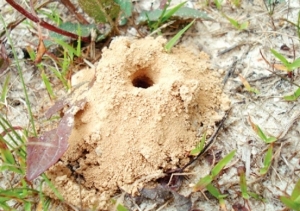Beetle busters
By Phyllis Moore
Published in News on June 24, 2010 1:46 PM

N.C. Department of Agriculture
The entrance to a wasp nest, usually identified by round holes like the one seen here, is usually the diameter of a pencil, surrounded by excavated soil and might be tucked beside or under a clump of grass.
There is a new type of battle going on at the softball fields at Wayne Community College.
Call it wasps vs. beetles -- literally.
The softball field at Wayne Community College is temporarily closed while researchers identify a strain of beetle they believe is responsible for killing all species of ash trees across North America.
The Emerald Ash Borer beetle is currently found in northern Virginia and the mountains of West Virginia. First discovered in Michigan in 2002, the problem has become widespread and continues to make its way through the Midwest and Mid-Atlantic states, according to the N.C. Department of Agriculture and Consumer Services.
There is no good way to monitor for the beetle using traditional techniques like traps, said Christine Nalepa, research specialist with Beneficial Insects Laboratory in Cary. She has spent the past two years surveying for the pests by using a native ground-dwelling wasp, Cerceris fumipennis, which feeds beetles to its young.
"We're surveying all over the state just to find the (wasp) nests at this point," she said. "If we do find a good site with a lot of nests, we monitor them."
Enter the Wayne Community College softball fields -- one of the best sites for locating the nests in eastern North Carolina, Ms. Nalepa said.
Part of her job is to intercept the female wasps and to collect the beetles and identify them, as a means to detect if a new pest is coming into the area, she said.
"We found the wasps have a preference where they put their nest -- hard-packed, human-disturbed, typically sandy soil. Baseball diamonds are ideal for that," she said.
The softball field at the college has been an attractive nesting place because it might not have been leveled in the off-season and is adjacent to a large stand of trees.
"We found initially more than 60 wasp nests, but it has been decreasing," Ms. Nalepa said Tuesday. "Wasps go through the life cycle so quickly."
Initially, the ground was marked with red flags and plastic covers were placed over the nests to prevent the female wasps from taking the beetles to the baby wasps. Officials estimated the project would take about two weeks to complete.
"We don't close it -- the wasps close it," Ms. Nalepa said. "The adult females, they'll be dying out and then the babies underground feed on the beetles. They'll turn into adults next spring. So the rest of the life cycle is underground."
The effort might also be of interest to area farmers, said Bill Thompson, associate vice president/institutional advancement at the college. They might want to keep an eye out for the possibility of wasp nests and beetle infestations, he said.
The college's softball field is expected to be closed until July 2. The gate will be locked and signs posted around the fenced area announcing the closure, officials said.
Meanwhile, when it reopens, Ms. Nalepa said, there is no danger in encountering the wasps.
"They don't sting. Most people don't even notice them," she said. "They're no danger to anybody at all."
For more information on the research effort, visit www.cerceris.info. To report finding a Cerceris fumipennis colony, contact Ms. Nalepa at 919-233-8214.
